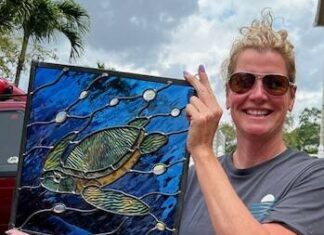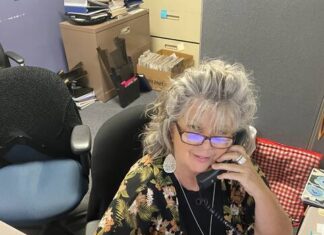AUGUSTA — An historical marker honoring the Fort Ancient Village People was unveiled at Appelman Park on Saturday during the Augusta Heritage Days.
The sign, that is just at the entrance of the park, gives background information on the Fort Ancient People.
The Fort Ancient people are believed to have lived in the Augusta area from 1500 to 1650 with the village being abandoned by 1650. They lived in villages along the Ohio River area from 1000 to 1750, where they grew crops and traded goods with other villages. They are believed to precede the Shawnee and other tribes.
Augusta Mayor Michael Taylor started the morning off by welcoming everyone to Augusta and to the dedication.
“Welcome to Augusta and the 47th annual Heritage Days and to this dedication,” he said. “The Augusta Rotary Club has worked very hard on the Heritage Days. This is a two day event for everyone.”
During the dedication ceremony, Dr. John Hale, with the University of Louisville, who led the team that was called to deal with the discovery of the Fort Ancient people in 1981.
“Sewage works were being put in along your river front here and they hit an ancient burial,” he said. “It wasn’t the bones that caught their attention. It was one of the graves had a mass of stone work over the grave. I had one of the most memorable experiences of my archaeological career, bringing some students who were studying archaeology with me.”
Hale gave some background on the people.
“In the last century, before the Europeans arrived, the women of these communities domesticated corn and it was a game changer for them,” he said. Corn started off as a wild grass with a seed about the size of a Bluegrass seed. The women, who were gathering everything to plant began to pick the biggest seeds from that original wild corn and began to plant those close to the community. Through the generations, picking the biggest seeds came up with our modern needs. It now feeds the world. So, what happened right here is the single most agriculture revolution of all carried out by these early Indian women.”
Hale gave a handout to those at the dedication that showed what was found during the excavation.
He said the burial site was a sacred site. There was a female skeleton and a pot that would have had food that would have been believed to follow the dead into the next world. There was also an infant buried with the woman.
“It was maybe a mother and child together,” he said.
On her forehead was evidence of a possible headdress when she was buried.
“She was a person of status,” he said. “Perhaps a sacred person who was buried with special emblems of reign. She has that lovely pot by her head and there were the bones of the small child within the first year of life. She was buried as if sleeping. Other Native American traditions have them curled up, but this is more like an eternal rest.”
Sarah Schmitt, the oral historian with the Kentucky Historical Society, spoke about the importance of preserving the history of Kentucky.
According the Schmitt, Kentucky is lucky to have the type of historical marker program that it does, because it is people driven.
“Other states have historical marker programs, but the society staff often have sole discretion of what sites should have markers, but that’s not the case in Kentucky. You determine what is historically significant in your communities, you conduct the research, draft the texts, find the sponsorship and you submit the application.”
Schmitt said every Kentucky county has at least one marker, if not more.
“Kentucky Historical Society has helped to place more than 2,400 markers illuminating Kentucky’s story,” she said. “It’s one of most noticeable ways the state historical society is able to engage with the entire Commonwealth from our home base in Frankfort. There is at least one marker in every Kentucky county and some have many, many more. I’m pleased to be part of any moment that helps to re-indigenize colonized space.”
Dr. Gwynn Henderson, the education director for Kentucky Archaeological Survey at Western Kentucky University and Dr. David Pollack, director of Kentucky Archaeological Survey also spoke during the dedication. Leah Frederick sand the National Anthem and My Old Kentucky Home and the marker was unveiled by Augusta resident Tay Kelsch, with the Augusta Rotary Club and Shmitt.






